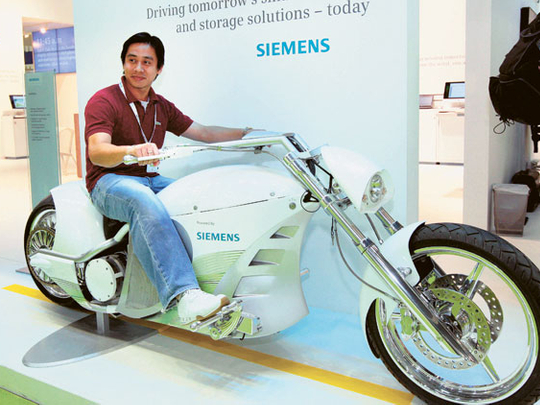
As Abu Dhabi hosted the World Future Energy Summit, for the fourth year and at an ever-growing size (thousands of participants, hundreds of companies, several world leaders, presidents, and ministers), experts have become convinced that nuclear and solar energy are economically and ecologically the best and smartest alternatives to fossil fuels (oil, coal, and gas).
The ecological attractiveness of solar energy is obvious: no carbon dioxide (CO2) emission. And with the growing awareness of the global warming problem and its connection to increased CO2 production, this is no small advantage.
The economic angle, however, has for long constituted the Achilles' heel of this renewable energy source: first, sunshine is received in small amounts in most of the regions that make up the developed world (especially Europe); secondly, the efficiency (and hence cost) of converting sun rays into electricity or other forms of energy has remained far from competitive.
What is new these days is that both of these negative factors are being overcome. The geographic problem is being resolved by setting up fields for harvesting sunshine in the Sahara, and perhaps in the Arabian desert. The technological problem is being surmounted by improvements in the techniques and materials used in the process — not to mention the fact that oil and gas prices have risen again and will likely continue to, loosening their grip on the market.
To understand how the Sahara solves the energy problem of Europe, we must first realise that due to its area size and geographic location, the North African desert each day receives more sunshine than Europe needs for energy consumption in a year. (The Arabian desert is much smaller, but it is still highly attractive, though it is not nearly as close to Western Europe.)
Secondly, recent developments in energy transport have made it possible to transfer electricity, by thick cables overland or undersea, over thousands of kilometres, with minimal loss.
And that is the project that Desertec, a consortium of 12 solid companies (including such big names as Siemens), has put together. It proposes to cover thousands of square kilometres of the Sahara desert (i.e. less than 1 per cent of its area) with solar heat collectors, enough to produce some 15 per cent of Europe's energy needs. The project leaders claim that by 2020, energy produced this way will be cheaper for Europeans than what is produced by local power plants.
But is the plan economically feasible? Can it be implemented and perhaps copied elsewhere, including the Gulf and the Middle East?
In Europe, an hour of conventional energy today costs about €0.06 (about one third of a dirham), and an hour of solar heat costs about €0.20 — not competitive at all.
In a sun-rich region, solar heat would cost about €0.15 or even €0.10, after technological improvements and large-scale industrial production of the required equipment.
Transport networks
Add to that the cost of installing the huge fields of solar collectors and the transport networks (big cables). It is estimated that the project would require about €400 billion in total over the next 40 years — quite a steep bill for someone to foot.
The proponents of the plan, however, argue that with increased demand, oil and gas are going to cost more and more, while the solar energy technology will become cheaper and more efficient.
Secondly, fossil fuel stocks are (very) limited, while sunshine is unlimited (the sun has another 5 billion years to go).
Thirdly, the carbon tax, if not the global rise in temperatures and its consequences, will soon force everyone to turn away from oil and gas, and indeed Europe has set for itself a goal of using 20 per cent renewable energy by 2020.
Indeed, a number of countries, including the UAE, Algeria, Morocco, and Egypt, have started to build solar thermal power plants. And China, India, and South Africa are seriously considering the technology. And if, as predicted, oil prices reach levels of $150 or even $200 a barrel, the US will certainly consider possible domestic implementations of plans such as Desertec.
But will such plans work in the UAE, the Gulf, and the Middle East, where solar radiation conditions are among the world's best, and where tax, labour, location, and infrastructure make a very attractive package.
The Masdar project is fully under way in Abu Dhabi: a carbon-free, waste-free city, where solar energy is fully used and recycling techniques are most efficiently applied. Masdar City will host 50,000 people and 1,500 eco-companies by 2020 or so.
In the wider Gulf and Middle East region, several leaders have expressed interest in such plans, including the Desertec project, though questions of who will pay for what, who will be responsible for what, etc., will need to be answered before anyone signs at the bottom line.
It remains to be seen whether the future will be sunny, grim, or hot for the next generations.
Nidhal Guessoum is Professor of Physics and Astronomy at the American University of Sharjah.








